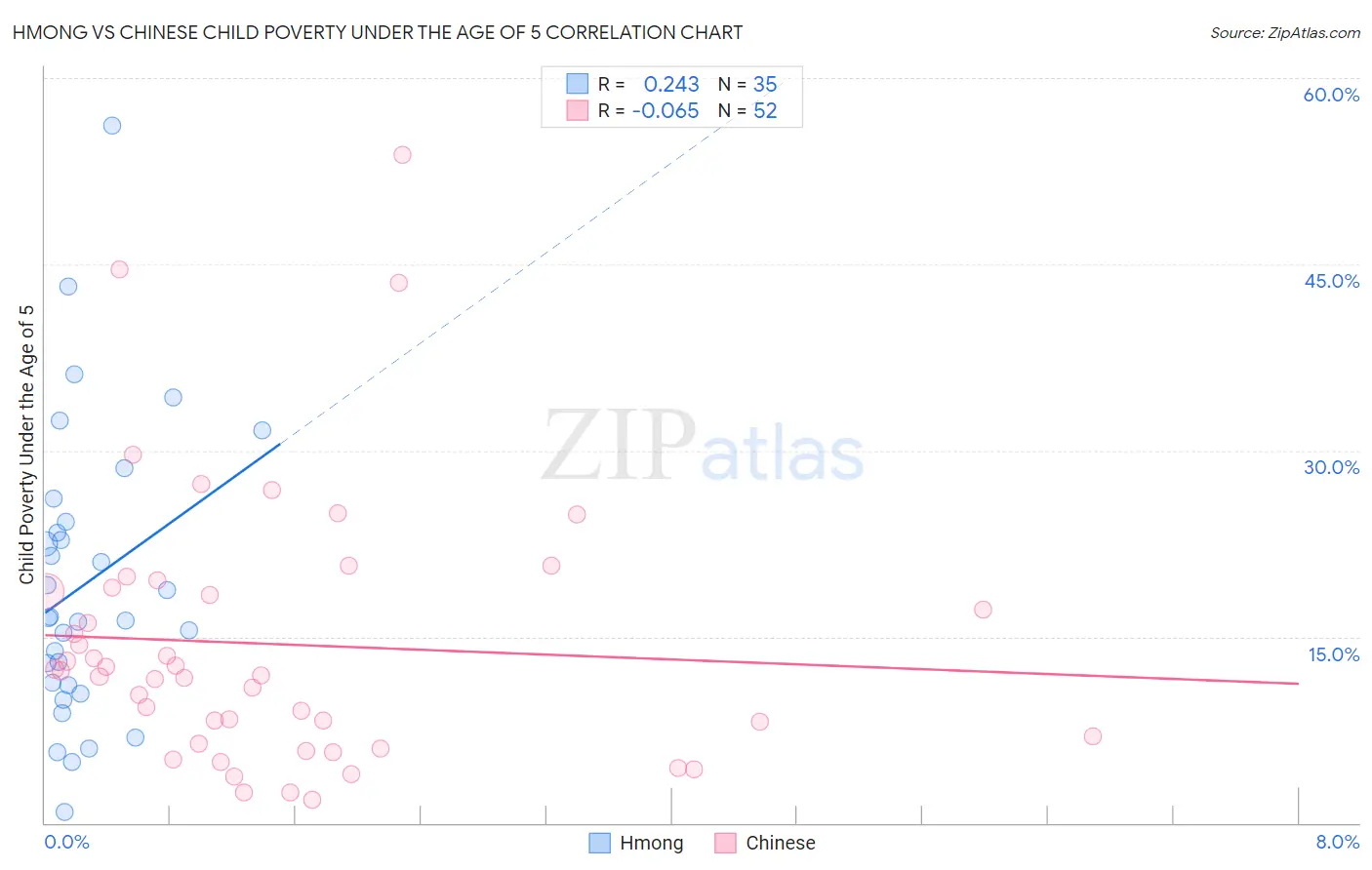Hmong vs Chinese Child Poverty Under the Age of 5
COMPARE
Hmong
Chinese
Child Poverty Under the Age of 5
Child Poverty Under the Age of 5 Comparison
Hmong
Chinese
18.5%
CHILD POVERTY UNDER THE AGE OF 5
5.0/ 100
METRIC RATING
216th/ 347
METRIC RANK
13.1%
CHILD POVERTY UNDER THE AGE OF 5
100.0/ 100
METRIC RATING
7th/ 347
METRIC RANK
Hmong vs Chinese Child Poverty Under the Age of 5 Correlation Chart
The statistical analysis conducted on geographies consisting of 24,630,682 people shows a weak positive correlation between the proportion of Hmong and poverty level among children under the age of 5 in the United States with a correlation coefficient (R) of 0.243 and weighted average of 18.5%. Similarly, the statistical analysis conducted on geographies consisting of 64,186,861 people shows a slight negative correlation between the proportion of Chinese and poverty level among children under the age of 5 in the United States with a correlation coefficient (R) of -0.065 and weighted average of 13.1%, a difference of 42.0%.

Child Poverty Under the Age of 5 Correlation Summary
| Measurement | Hmong | Chinese |
| Minimum | 0.91% | 1.9% |
| Maximum | 56.2% | 53.8% |
| Range | 55.3% | 52.0% |
| Mean | 19.2% | 14.4% |
| Median | 16.5% | 12.1% |
| Interquartile 25% (IQ1) | 11.1% | 6.7% |
| Interquartile 75% (IQ3) | 24.2% | 18.8% |
| Interquartile Range (IQR) | 13.2% | 12.1% |
| Standard Deviation (Sample) | 11.6% | 10.8% |
| Standard Deviation (Population) | 11.5% | 10.7% |
Similar Demographics by Child Poverty Under the Age of 5
Demographics Similar to Hmong by Child Poverty Under the Age of 5
In terms of child poverty under the age of 5, the demographic groups most similar to Hmong are Immigrants from Africa (18.6%, a difference of 0.20%), Immigrants from Panama (18.5%, a difference of 0.46%), Malaysian (18.4%, a difference of 0.66%), Delaware (18.7%, a difference of 0.95%), and German Russian (18.8%, a difference of 1.3%).
| Demographics | Rating | Rank | Child Poverty Under the Age of 5 |
| Spanish | 9.8 /100 | #209 | Tragic 18.2% |
| Panamanians | 9.7 /100 | #210 | Tragic 18.2% |
| Moroccans | 9.4 /100 | #211 | Tragic 18.2% |
| Nepalese | 8.7 /100 | #212 | Tragic 18.3% |
| Immigrants | Thailand | 8.6 /100 | #213 | Tragic 18.3% |
| Malaysians | 6.5 /100 | #214 | Tragic 18.4% |
| Immigrants | Panama | 6.0 /100 | #215 | Tragic 18.5% |
| Hmong | 5.0 /100 | #216 | Tragic 18.5% |
| Immigrants | Africa | 4.6 /100 | #217 | Tragic 18.6% |
| Delaware | 3.4 /100 | #218 | Tragic 18.7% |
| German Russians | 3.0 /100 | #219 | Tragic 18.8% |
| Immigrants | Azores | 2.6 /100 | #220 | Tragic 18.9% |
| Immigrants | Nigeria | 2.1 /100 | #221 | Tragic 19.0% |
| Alsatians | 1.7 /100 | #222 | Tragic 19.1% |
| Cubans | 1.7 /100 | #223 | Tragic 19.1% |
Demographics Similar to Chinese by Child Poverty Under the Age of 5
In terms of child poverty under the age of 5, the demographic groups most similar to Chinese are Iranian (13.1%, a difference of 0.020%), Immigrants from Iran (13.1%, a difference of 0.17%), Immigrants from Singapore (12.9%, a difference of 0.98%), Burmese (13.2%, a difference of 1.3%), and Immigrants from Korea (13.2%, a difference of 1.4%).
| Demographics | Rating | Rank | Child Poverty Under the Age of 5 |
| Immigrants | India | 100.0 /100 | #1 | Exceptional 11.5% |
| Immigrants | Taiwan | 100.0 /100 | #2 | Exceptional 11.6% |
| Filipinos | 100.0 /100 | #3 | Exceptional 11.6% |
| Thais | 100.0 /100 | #4 | Exceptional 12.3% |
| Immigrants | Hong Kong | 100.0 /100 | #5 | Exceptional 12.4% |
| Immigrants | Singapore | 100.0 /100 | #6 | Exceptional 12.9% |
| Chinese | 100.0 /100 | #7 | Exceptional 13.1% |
| Iranians | 100.0 /100 | #8 | Exceptional 13.1% |
| Immigrants | Iran | 100.0 /100 | #9 | Exceptional 13.1% |
| Burmese | 100.0 /100 | #10 | Exceptional 13.2% |
| Immigrants | Korea | 100.0 /100 | #11 | Exceptional 13.2% |
| Immigrants | South Central Asia | 100.0 /100 | #12 | Exceptional 13.3% |
| Bhutanese | 100.0 /100 | #13 | Exceptional 13.4% |
| Okinawans | 100.0 /100 | #14 | Exceptional 13.4% |
| Indians (Asian) | 100.0 /100 | #15 | Exceptional 13.4% |